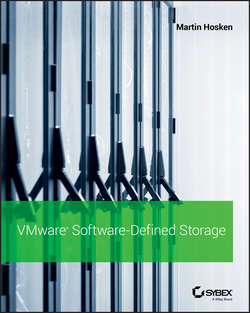VMware Software-Defined Storage

Реклама. ООО «ЛитРес», ИНН: 7719571260.
Оглавление
Martin Hosken. VMware Software-Defined Storage
About the Author
About the Technical Reviewer
Foreword by Duncan Epping
Introduction
Who Should Read This Book?
What Is Covered in This Book?
Chapter 1. Software-Defined Storage Design
Software-Defined Compute
Software-Defined Networking
Software-Defined Storage
Designing VMware Storage Environments
The Economics of Storage
Implementing a Software-Defined Storage Strategy
Chapter 2. Classic Storage Models and Constructs
Classic Storage Concepts
vSphere Storage Technologies
Chapter 3. Fabric Connectivity and Storage I/O Architecture
Fibre Channel SAN
iSCSI Storage Transport Protocol
NFS Storage Transport Protocol
Fibre Channel over Ethernet Protocol
Multipathing Module
Direct-Attached Storage
Evaluating Switch Design Characteristics
Fabric Connectivity and Storage I/O Architecture Summary
Chapter 4. Policy-Driven Storage Design with Virtual SAN
Virtual SAN Overview
Virtual SAN Architecture
Virtual SAN Design Requirements
Virtual SAN Network Fabric Design
Virtual SAN Storage Policy Design
Virtual SAN Datastore Design and Sizing
Designing for Availability
Virtual SAN Internal Component Technologies
Virtual SAN Integration and Interoperability
Chapter 5. Virtual SAN Stretched Cluster Design
Stretched Cluster Use Cases
Fault Domain Architecture
Witness Appliance
Network Design Requirements
Stretched Cluster Deployment Scenarios
Default Gateway and Static Routes
Stretched Cluster Storage Policy Design
Preferred and Nonpreferred Site Concepts
Stretched Cluster Read/Write Locality
Distributed Resource Scheduler Configurations
High Availability Configuration
Stretched Cluster WAN Interconnect Design
Deploying Stretched VLANs
Data Center Interconnect Design Considerations Summary
Stretched Cluster Solution Architecture Example
Stretched Cluster Failure Scenarios
Stretched Cluster Interoperability
Chapter 6. Designing for Web-Scale Virtual SAN Platforms
Scale-up Architecture
Scale-out Architecture
Designing vSphere Host Clusters for Web-Scale
Building-Block Clusters and Scale-out Web-Scale Architecture
Scalability and Designing Physical Resources for Web-Scale
Leaf-Spine Web-Scale Architecture
Chapter 7. Virtual SAN Use Case Library
Use Cases Overview
Solution Architecture Example: Building a Cloud Management Platform with Virtual SAN
Chapter 8. Policy-Driven Storage Design with Virtual Volumes
Introduction to Virtual Volumes Technology
Management Plane
Data Plane
Storage Policy–Based Management with Virtual Volumes
Benefits of Designing for Virtual Volumes
Virtual Volumes Key Design Requirements
vSphere Storage Feature Interoperability
VAAI and Virtual Volumes
Virtual Volumes Summary
Chapter 9. Delivering a Storage-as-a-Service Design
STaaS Service Definition
Cloud Platforms Overview
Cloud Management Platform Architectural Overview
The Combined Solution Stack
Workflow Examples
Summary
Chapter 10. Monitoring and Storage Operations Design
Storage Monitoring
Storage Component Monitoring
Storage Monitoring Challenges
Common Storage Management and Monitoring Standards
Virtual SAN Monitoring and Operational Tools
vRealize Operations Manager
vRealize Log Insight
Log Insight Syslog Design
End-to-End Monitoring Solution Summary
Storage Capacity Management and Planning
Summary
Отрывок из книги
Martin Hosken is employed as a global cloud architect within the VMware Global Cloud Practice, which is part of its Cloud Provider Software Business Unit.
He has extensive experience architecting and consulting with international customers and designing the transition of organizations' legacy infrastructure onto VMware cloud-based platforms. His broad and deep knowledge of physical and virtualized services, platforms, and cloud infrastructure solutions is based on involvement and leadership in the global architecture, design, development, and implementation of large-scale, complex, multitechnology projects for enterprises and cloud service providers. He is a specialist in designing, implementing, and integrating best-of-breed, fully redundant Cisco, EMC, IBM, HP, Dell, and VMware systems into enterprise environments and cloud service providers' infrastructure.
.....
Despite these falling costs in raw disk storage capacity, the chassis, the disk shelves used to create disk arrays, and the storage controllers tasked with organizing disks into large RAID (redundant array of independent disks) or JBOD (just a bunch of disks) sets, vendor prices for their technologies continue to increase year after year, regardless of this growing commoditization of the components used by them.
The reason for this is the ongoing development and sophistication of vendor software. For instance, an array made up of commoditized components, including 300 2 TB disks stacked in commodity shelves, may have a hardware cost totaling approximately $4,000. However, the end array vendor might assign a manufacturer’s suggested retail price tag of $400,000. This price is based on the vendor adding their secret source software, enabling the commodity hardware to include features such as manageability and availability and to provide the performance aspects required by its customers, while also allowing the vendor to differentiate their product from that of their competitors. It is this aspect of storage that often adds the most significant cost component to storage technologies, regardless of the actual value added by the vendor’s software, or which of those added features are actually used by their customers.
.....